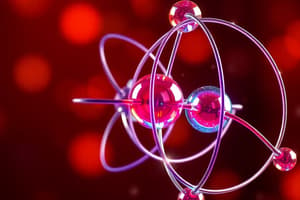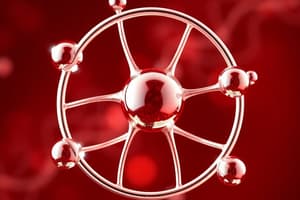Podcast
Questions and Answers
What type of bond involves the sharing of electrons between atoms?
What type of bond involves the sharing of electrons between atoms?
- Covalent bond (correct)
- Ionic bond
- Metallic bond
- Atomic orbital bond
Which bond is formed by the transfer of electrons from one atom to another?
Which bond is formed by the transfer of electrons from one atom to another?
- Atomic orbital bond
- Covalent bond
- Metallic bond
- Ionic bond (correct)
Which type of bond is responsible for the electrical conductivity of metals?
Which type of bond is responsible for the electrical conductivity of metals?
- Covalent bond
- Ionic bond
- Atomic orbital bond
- Metallic bond (correct)
What is the primary characteristic of an ionic bond?
What is the primary characteristic of an ionic bond?
Which type of bond is characterized by the formation of atomic orbitals?
Which type of bond is characterized by the formation of atomic orbitals?
What property enables metallic bonds to conduct electricity?
What property enables metallic bonds to conduct electricity?
What type of bond is formed by the attraction between positive and negative ions?
What type of bond is formed by the attraction between positive and negative ions?
Which type of bond is formed by the sharing of electrons between atoms to attain a stable electron configuration?
Which type of bond is formed by the sharing of electrons between atoms to attain a stable electron configuration?
What type of bond is responsible for the high electrical conductivity of metals?
What type of bond is responsible for the high electrical conductivity of metals?
What type of bond is formed by the attraction between positive ions and a sea of delocalized electrons?
What type of bond is formed by the attraction between positive ions and a sea of delocalized electrons?
What is the term for a bond formed by the unequal sharing of electrons, resulting in partially positive and partially negative ends of the bond?
What is the term for a bond formed by the unequal sharing of electrons, resulting in partially positive and partially negative ends of the bond?
What is the term for the overlap of atomic orbitals to form a localized region of electron density between the nuclei of bonded atoms?
What is the term for the overlap of atomic orbitals to form a localized region of electron density between the nuclei of bonded atoms?
What type of bond is formed by the attraction between positive ions and negative ions?
What type of bond is formed by the attraction between positive ions and negative ions?
How does electronegativity help determine the polarity of a bond?
How does electronegativity help determine the polarity of a bond?
Which type of bond involves the pooling of electrons in a 'sea' shared by all the atoms in a metal?
Which type of bond involves the pooling of electrons in a 'sea' shared by all the atoms in a metal?
What type of bond is formed by the sharing of electrons between atoms to attain a stable electron configuration?
What type of bond is formed by the sharing of electrons between atoms to attain a stable electron configuration?
How does electronegativity help determine the polarity of a bond?
How does electronegativity help determine the polarity of a bond?
What is the term for the overlap of atomic orbitals to form a localized region of electron density between the nuclei of bonded atoms?
What is the term for the overlap of atomic orbitals to form a localized region of electron density between the nuclei of bonded atoms?
What type of bond is formed by the attraction between positive ions and a sea of delocalized electrons?
What type of bond is formed by the attraction between positive ions and a sea of delocalized electrons?
How does electronegativity help determine the polarity of a bond?
How does electronegativity help determine the polarity of a bond?
What is the term for the overlap of atomic orbitals to form a localized region of electron density between the nuclei of bonded atoms?
What is the term for the overlap of atomic orbitals to form a localized region of electron density between the nuclei of bonded atoms?
Which type of bond is responsible for the high electrical conductivity of metals?
Which type of bond is responsible for the high electrical conductivity of metals?
What is the term for the overlap of atomic orbitals to form a localized region of electron density between the nuclei of bonded atoms?
What is the term for the overlap of atomic orbitals to form a localized region of electron density between the nuclei of bonded atoms?
What type of bond is formed by the attraction between positive and negative ions?
What type of bond is formed by the attraction between positive and negative ions?
What type of bond is characterized by the sharing of electrons between atoms to attain a stable electron configuration?
What type of bond is characterized by the sharing of electrons between atoms to attain a stable electron configuration?
Which bond is formed by the attraction between positive ions and a sea of delocalized electrons?
Which bond is formed by the attraction between positive ions and a sea of delocalized electrons?
What is the term for the overlap of atomic orbitals to form a localized region of electron density between the nuclei of bonded atoms?
What is the term for the overlap of atomic orbitals to form a localized region of electron density between the nuclei of bonded atoms?
What type of bond is formed by the attraction between positive ions and a sea of delocalized electrons?
What type of bond is formed by the attraction between positive ions and a sea of delocalized electrons?
What property enables metallic bonds to conduct electricity?
What property enables metallic bonds to conduct electricity?
What is the term for the overlap of atomic orbitals to form a localized region of electron density between the nuclei of bonded atoms?
What is the term for the overlap of atomic orbitals to form a localized region of electron density between the nuclei of bonded atoms?
What type of bond is characterized by the sharing of electrons between atoms to attain a stable electron configuration?
What type of bond is characterized by the sharing of electrons between atoms to attain a stable electron configuration?
How does electronegativity contribute to determining the polarity of a bond?
How does electronegativity contribute to determining the polarity of a bond?
Which type of bond involves a lattice of positive ions surrounded by a 'sea' of delocalized electrons?
Which type of bond involves a lattice of positive ions surrounded by a 'sea' of delocalized electrons?
What type of bond is formed by the attraction between positive ions and a sea of delocalized electrons?
What type of bond is formed by the attraction between positive ions and a sea of delocalized electrons?
How does electronegativity help determine the polarity of a bond?
How does electronegativity help determine the polarity of a bond?
What is the primary characteristic of an ionic bond?
What is the primary characteristic of an ionic bond?
What type of bond is formed by the attraction between positive ions and a sea of delocalized electrons?
What type of bond is formed by the attraction between positive ions and a sea of delocalized electrons?
How does electronegativity contribute to determining the polarity of a bond?
How does electronegativity contribute to determining the polarity of a bond?
What is the term for the overlap of atomic orbitals to form a localized region of electron density between the nuclei of bonded atoms?
What is the term for the overlap of atomic orbitals to form a localized region of electron density between the nuclei of bonded atoms?
In an ionic bond, what is the primary characteristic?
In an ionic bond, what is the primary characteristic?
What type of bond is characterized by the sharing of electrons between atoms to attain a stable electron configuration?
What type of bond is characterized by the sharing of electrons between atoms to attain a stable electron configuration?
How does electronegativity contribute to determining the polarity of a bond?
How does electronegativity contribute to determining the polarity of a bond?




